Matador Network's Blog, page 1048
July 25, 2019
Classic, non-touristy Dublin pubs
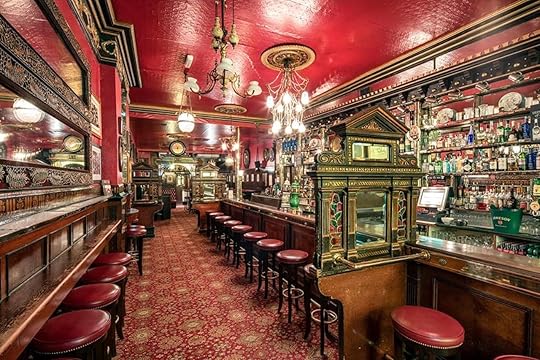
No one needs to tell you that Dublin is a drinking town. As Ireland’s beloved author James Joyce famously wrote in Ulysses, a “good puzzle would be to cross Dublin without passing a pub.” A good puzzle and also a near-impossible one.
On a recent trip to Ireland, my driver taking me from the airport to my hotel offered up the best advice I’ve heard about getting a good Guinness in an Irish pub. “Walk into a bar and if everyone has a Guinness, it’s a good place,” he said. “If everyone has a lager and only one person has a Guinness, probably not a good place for a Guinness.”
It’s as simple as that. There are more than 750 pubs in Dublin, not including hotel bars and restaurants. Many have the level of charm that’s made the Irish pub one of the country’s most exported cultural institutions. Nearly all of them pour a proper pint of Guinness. All this is to say that it’s easy to find the proper Irish pub experience in Dublin — so long as you avoid the frenzied tourist masses in and around Temple Bar.
If you feel the need to be a part of the never-ending stream of people with a picture in front of Temple Bar and socialize with other travelers instead of locals, by all means, do so. Then leave for a pint somewhere else to enjoy typical Irish craic (banter) in a snug (walled-off section of the pub for small groups).
These are the best non-touristy Dublin pubs to drink at.
1. Ryan’s of Parkgate Street
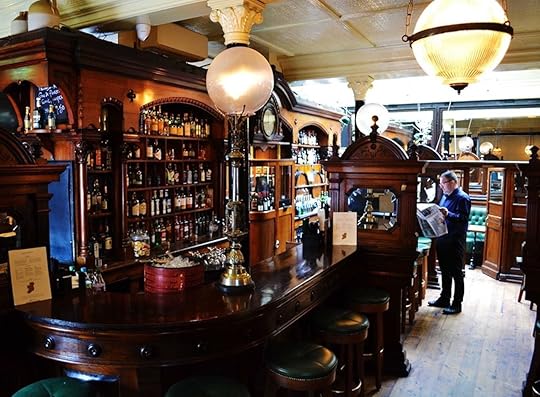
Photo: Ryan’s of Parkgate Street by F.X. Buckley/Facebook
Located across the River Liffey from Guinness’s James’s Gate Brewery, Ryan’s of Parkgate Street has what is widely considered one of the best food menus of all of Dublin’s pubs. Think wild Irish rabbit, pâté, ribeye, and oysters. It’s attached to and run by an outpost of the F.X. Buckley Steakhouse chain, which was started in the 1930s by high-end butchers (also the same butchers that Joyce’s Leopold Bloom buys his kidneys from in Ulysses). Ryan’s is the pub section of the restaurant and doesn’t have the full steakhouse menu — yet it also lacks the prices that come with a high-end steakhouse.
The pub is a throwback to the detail-oriented design of the Victorian era, with a long wooden bar and opulent wood dividers that separate the bar into sections. Above the liquor selection in the middle of the bar, you’ll find the oldest two-faced clock in Ireland. If you’re looking for something a little more private, there are two snugs perfect for small groups who want to chat amongst themselves. Ryan’s of Parkgate Street rigidly sticks to the Victorian decor, including the match striking plates next to each table that used to be used to light patron’s cigarettes (though smoking is no longer allowed inside).
Where: 28 Parkgate St, Stoneybatter, Dublin 8, Ireland
2. The Long Hall

Photo: The Long Hall Pub/Facebook
The Long Hall is another Victorian bar with ornate, yet inviting, decor. It’s immediately recognizable by the white-and-red-striped awning and the, well, long hall in the front section that leads to the proper sitting room in the back. The first bar license for The Long Hall dates back to 1766 while the interior design is from 1881. Another date to keep in mind: 1951, the year women were finally allowed to drink at the bar.
The walls are filled with photographs of royalty from abroad and plaques of excellence. Intricate wood carvings are everywhere you look, including along the mahogany back bar, and it’s hard to miss the gold leaf adorning the bar’s furniture. The carpet (yes, carpet, in the spill-heavy environment of a bar) is itself a piece of art with a bright red hue and golden designs.
Despite its posh interior, The Long Hall is anything but pretentious. On a Dublin weekday night, a couple colleagues and myself got caught up talking with a group of ex-Navy men who were in a whiskey drinking club. The Long Hall was the right place to be, thanks to its many specialty whiskeys from brands like Jameson, Powers, and Tullamore D.E.W. kept in stock.
It’s easy to spot the occasional tourist who walks in looking for a pint and whiskey, but they’re dispersed among the locals and regulars. Also known to make a stop when in town: Bruce Springsteen, Sean Penn, and Rihanna.
Where: 51 South Great George’s Street, Dublin 2, Ireland
3. Idlewild

Photo: Idlewild Dublin/Facebook
Dublin isn’t all old pubs with centuries-old liquor licenses. Dublin is a modern city with a modern cocktail scene, and one of the newest and most notable is Idlewild. Here, you’ll find a well-curated selection of Irish craft beer and innovative cocktails. The main reason to come, however, is for the boilermakers. A dedicated menu of house-chosen beer-and-a-shot combos includes options like the Cork Boi (Powers Three Swallows paired with Eight Degrees: The Full Irish) and the Paint Me Like Your French Cailín (a small Boulevardier cocktail paired with a seasonal Irish red ale). Idlewild is credited by one Irish publication to have brought the beer and a shot to the mainstream in Dublin.
The name, design, and feel of the bar are inspired by the Idlewild Bar constructed in the 1940s when the Idlewild golf course was converted into what is now JFK International Airport in New York City. Irish teamsters and mob bosses were said to be involved in the making of the bar, which in its heyday attracted people like Frank Sinatra, Dean Martin, Marylin Monroe, and John F. Kennedy.
Find the entrance to Idlewild underneath a small neon BAR sign. The door itself is immediately recognizable by the stained-glass pattern with a Diamond P design in the center, a callback to Powers Irish Whiskey, which once owned the building and bottled the first commercially produced mini bottles of liquor here. Inside, there’s a mix of tall communal tables and comfy couches. A fireplace and too many books to count give it a cozy feel, while a large disco ball in the middle of the main room shows the bar doesn’t take itself too seriously.
Where: 14 Fade St, Dublin 2, Ireland
4. John Kavanagh, Gravediggers

Photo: John Kavanagh “The Gravediggers”/Facebook
John Kavanagh, popularly known as Gravediggers, is out of the way in north Dublin. It’s worth the cab ride over for the most peaceful pint in the city.
The bar gets its nickname from Glasnevin Cemetery next door. It shares a wall with the graveyard, and mourners and cemetery workers have frequented the pub since it opened in 1833. It’s been in the Kavanagh family for seven generations and has its fair share of ghost stories. The only thing you’ll be thinking about when drinking here, however, is the perfect pint of Guinness. There are no TVs in the pub, and singing, dancing, and phone calls are expressly forbidden — and the ban is taken seriously. Proof in point: When band members from U2, The Dubliners, and others pulled out their instruments in the bar after the 1984 funeral at Glasnevin for The Dubliners’ lead singer, then-owner Eugene Kavanagh told them they’d have to pack up their stuff because no music is allowed.
The wooden benches and tables that form small, open-faced snugs verge on austere. About the only decor you’ll find on the walls are patches from police departments around Dublin and the world and newspaper articles about visits from Anthony Bourdain and other lovers of good drink. There will be locals sitting at the short bar (often with a dog or two) as well as a smattering of people who’ve come to check out what, exactly, made Bourdain love this bar so much. What you won’t find is a crowd of tourists other than the occasional Dublin ghost hunting bus passing by.
Along with beer and whiskey, there are small plates served every day but Sunday. Keep in mind that it’s cash only and pay your respects next door after your pint.
Where: 1 Prospect Square, Glasnevin, Dublin, D09 CF72, Ireland
5. The Beer Market

Photo: The Beer Market/Facebook
Yes, Dublin is a Guinness town, and yes, you should have as many pints of the stuff as you can. Yet it’s also a good idea to check out the local craft beer scene that’s cropped up in recent years. The Beer Market is a bar owned by Ireland’s Galway Bay Brewery and has 15-plus beers on tap from local breweries, as well as from international brands like Sierra Nevada and Founders. You won’t find a single line of Guinness, but try the house-made stout.
Beer Market holds a special place in Dublin’s beer scene. As much as 90 percent of the beers on tap can only be found at the bar. It’s across from a portion of the Old Dublin City Wall that still stands and is next door to St. Audoen’s Catholic church. Beer Market is one of the few bars in Dublin that serves only beer, no liquor, and is the perfect place to avoid the Guinness-chasing tourists.
Where: 13 High St, The Liberties, Dublin 8, Ireland
6. The Cobblestone

Photo: The Cobblestone/Facebook
The Cobblestone attracts a mix of customers, but the vibe is authentic Irish. The out-of-the-way pub is small and made smaller by the live music that plays every night and attracts a crowd. Find Cobblestone in Smithfield, one of Dublin’s oldest neighborhoods. The Mulligan family that runs the bar has played traditional Irish music and attracted musicians far and wide for decades. The bar is still family-owned and run and describes itself as a “drinking pub with a music problem.” Make sure to come early for a spot.
Where: 77 King St N, Smithfield, Dublin, D07 TP22, Ireland
7. John Fallon’s The Capstan Bar
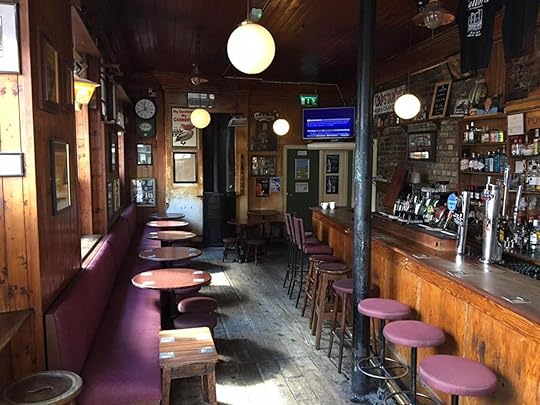
Photo: John Fallon’s “The Capstan Bar”/Facebook
John Fallon’s is about as local a bar as they come. There’s been a bar on this plot of land since the 1600s, and it was a favorite of the workers from the Powers distillery when the brand produced all its whiskey in Dublin. It’s been through a lot over the centuries. There have been fires and secret meetings, times of hardship and changing economic conditions. Still the bar stands, and on any given day you’ll find locals sitting at the bar talking with the bartender and watching a horse race or sports match on one of the two small TVs.
The small space looks like what all of the “traditional Irish pubs” around the world are going for. It’s a decidedly working-class haunt, with light wood fixtures and a small snug in the front corner just big enough for five people to sit comfortably. Photos of regulars adorn the walls next to poems and letters they wrote to the bar.
Stop here for a snack along with your beer and whiskey. The ham, cheese, and tomato toasties (basically an Irish grilled cheese) are soul-warming on a brisk Dublin day when served alongside a small bowl of warm tomato soup.
Where: 129 The Coombe, The Liberties, Dublin 8, D08 NP52, Ireland 

More like this: The ultimate 72-hour travel guide to Dublin
The post The best non-touristy pubs in Dublin to drink at instead of Temple Bar appeared first on Matador Network.

Swimply lets you rent out your pool

There’s nothing worse than when it’s 100 degrees outside, and you find yourself forced to stare enviously across the street at your neighbors splashing around in their pool, because you don’t have one. The new Swimply service is seeking to remedy that. Launched just a few weeks ago, the website allows you to post your backyard pool online and rent it out by the hour to complete strangers. Basically, you’re Airbnbing your pool.
Swimply’s founder, Michael White, had the idea because he rarely uses his pool that he installed 15 years ago, and was brainstorming creative ways it could be put to use. Business is slow so far, but White believes “it’s probably because it’s just so new that nobody has heard of it.” Of course, every pool is inspected before it’s posted, and renters must sign a waiver that doesn’t hold them liable for accidents.
On the website and app, you can read about the available pools, look at reviews, and book your time slot. The average price is $45 per hour, which is dirt cheap if you’re splitting it with friends, though it varies depending on amenities, pool size, location, and demand.
White is based in the Houston area, but there are dozens of new owners renting out their pools every day nationwide. 

More like this: The 11 dreamiest swimming pools in the world you can visit this summer
The post This new website is the Airbnb of renting your pool out to strangers appeared first on Matador Network.

Bella Swan’s ‘Twilight’ house Airbnb

Bella and Edward found their perfect piece of forever and moved on from her family home in Forks, but that just means that you now have your own shot at a blissful Twilight lifestyle — her house from the movies is now on Airbnb. After being put up for sale last year, the house’s new owners have officially put it up for rent on Airbnb. No, it’s not in Forks, Washington, like the movies would have you believe, but actually in St. Helens, Oregon, where much of the filming took place.
At the start of Twilight, Bella moves from Phoenix to Forks, Washington, to live with her father, Charlie Swan. The house is where Edward picked Bella up for the first time in a shiny silver Volvo (and several times thereafter), where Bella researched Edward’s abilities and came to the conclusion that he was a vampire, where they had their first kiss, and where she and Charlie had their argument toward the end of the film. And, maybe less significant but still just as endearing, it’s also where Charlie picked up his shotgun right before Edward walks inside to be introduced.
The house was used all throughout the first movie for filming, an exact replication was created on a soundstage for the sequels.

Photo: Airbnb
Dean and Amber, the home’s owners, invite you to “take photos recreating all of your favorite Twilight scenes!” Guests will be able to sleep in the same room Bella did, dine at the same time she and Charlie ate at, and more. Oh, and there are also Twilight cardboard character cutouts scattered throughout the house to watch you sleep.

Photo: Airbnb
If you’re interested, don’t drag your feet. They’re currently accepting bookings eight months in advance. Each night costs $330, and there’s a two night minimum. 
This article was updated on July 25, 2019.

More like this: You can buy House Tully’s Riverrun castle from 'Game of Thrones'
The post You can now rent Bella Swan’s house from ‘Twilight’ on Airbnb, and yes, there are cardboard cutouts appeared first on Matador Network.

What can bring through customs

Horror stories of travelers getting their expensive Italian cheese confiscated at the border and tales of people getting blacklisted and fined for bringing fruit into the United States have us all sweating nervously through customs. To avoid having to defend yourself for a tomato sandwich or a funny-looking Louis Vuitton handbag, make sure everything in your luggage, including souvenirs, adheres to the (sometimes surprising) US border policies. Here are 10 items travelers often wonder if they can take back with them, and whether or not they’ll make it past customs.
1. Cultural artifacts: No

Photo: Aleksandar Todorovic/Shutterstock
Most countries have laws protecting their cultural property in an effort to preserve their unique heritage. Cultural property can be anything from art to antiquities to archaeological artifacts. Imports that US law currently prohibits includes pre-Colombian art from Central or South America, Native American property from Canada, terracotta sculptures from Mali, and Cambodian Khmer stone artifacts. Customs and Border Protection (CBP) encourages contacting them for a full list of prohibited items.
However, even with a permit from the country of origin, the specific laws are murky. To avoid confiscation and a hefty fine, leave any original cultural artifacts behind.
2. Absinthe: Technically, yes

Photo: Jeff Bukowski/Shutterstock
You probably already know that bringing alcohol into the US is legal under a certain limit; however, there are exceptions to this rule.
Absinthe, a highly alcoholic beverage distilled with wormwood and anise, originated in Switzerland, and has a long history of prohibition in the US. Fabled to be the alcohol that inspired the art of Pablo Picasso and Vincent van Gogh, there’s a great deal of mystique surrounding the beverage.
However, stories of absinthe acting as a psychoactive hallucinogen are largely false. In reality, absinthe, although much more potent than your typical German beer, is just another alcohol.
Despite absinthe being legalized in 2007, that doesn’t necessarily mean that you can bring a bottle back in your luggage. Any absinthe you bring back must be “thujone-free” — in other words, it must contain less than 10 parts per million of thujone, the chemical component in wormwood that was once thought to be responsible for hallucinations. “Absinthe” cannot be the brand name or written anywhere on the label. Artwork on the bottle cannot suggest any hallucinogenic or mind-altering effects.
So, the verdict — technically, yes, you can bring absinthe into the US, but you have to be positive it adheres to the specific rules surrounding it.
3. Dog and cat fur: No

Photo: ChiccoDodiFC/Shutterstock
Since 2000, it is fully illegal to import, export, distribute, transport, or manufacture products containing dog or cat fur in the US. You will also be fined up to $10,000, depending on whether your violation was intended or by mistake.
Even if the idea of ever wearing a dog fur coat sends a shiver down your spine, still beware. Some countries that do participate in the dog and cat fur trade — such as China — have been found intentionally mislabelling products in order to bypass the US’ ban. Investigations by the Humane Society and other organizations have discovered dog and cat fur labelled as mink or fox fur — and also under more ambiguous names such as or “Asiatic raccoon” or “coyote.” If you find yourself suspicious of an article of clothing purchased abroad, the only way to be sure you’re not participating in this industry is to stick to faux fur altogether.
4. Fruits and veggies: Depends

Photo: Alexander Raths/Shutterstock
Whether or not you’ll be able to bring home that airport banana is dependent on what country you are coming from and where you intend to go after you arrive in the US. CBP is such a stickler because fresh fruits and vegetables can introduce plant pests or diseases into the US. The same goes for live plants and plant seeds.
The Mediterranean fruit fly outbreak of the 1980s was due to importation of contaminated Mediterranean tomatoes. The invasive species cost the state of California $100 million to eliminate the problem. To avoid outbreaks like this in the future, all fruits and vegetables entering the US must be declared and inspected. Don’t be surprised if border control asks you to toss that apple you were thinking of snacking on during the ride home — just ask the Delta passenger who was fined $500 for an apple given to her during her flight by the airline staff.
5. Live animals: Depends on species and circumstances

Photo: eva_blanco/Shutterstock
Another huge gray area, the transportation of live animals — pets or not — is subject to a long list of dependencies.
Pets, except for pet birds, that are returning home are subject to the same procedures and restrictions as animals entering the US for the first time. This process could include quarantines, vaccinations, and even prohibition. Pet birds returning to the US are subject to different restrictions dependent on whether they are of US or foreign origin.
The Centers for Disease Control requires that all dogs and cats are healthy and vaccinated against rabies. Bats, civets, African rodents, and non-human primates may not be transported as pets under any circumstances. CBP gives a lengthy list of rules — including some seemingly unusual ones, such as a restriction on the “importation of turtles with a shell length of less than 4 inches” — which can be found on its website. Additional laws apply to certain US territories, such as Guam and Hawaii.
Whether you’re taking your pet on vacation or for permanent relocation, it is best to give CBP a call to avoid any complications.
6. Drug paraphernalia: No

Photo: content_creator/Shutterstock
Whether you intend to use it for its intended purpose or just as a keepsake, it is illegal to bring drug paraphernalia into the US unless prescribed for an authentic medical condition. Drug paraphernalia — anything that is used to make, use, or conceal drugs — will be confiscated. This includes everything from marijuana vaporizers to hollowed-out books meant to hide illicit substances. In certain circumstances, you could face heavy fines or even arrest.
The one exception to this rule: Tobacco pipes are allowed in your luggage or carry-on.
7. Medicine: Yes

Photo: BigKhem/Shutterstock
The restriction on drugs and drug paraphernalia may cause you concern if you need to bring medicine on your vacation.
Medicine prescribed for a medical condition is completely legal to transport through the US. border. You should not bring more than a 90-day supply, and all medicine should be transported in the original container with the doctor’s prescription written on the label. If you move the medicine to another container, make sure you bring along a signed doctor’s note.
In addition, any medication entering the US from a foreign country must be accompanied by a doctor’s note.
8. Counterfeit brand clothes: No
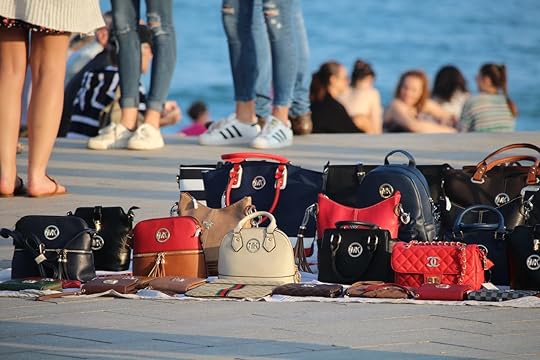
Photo: Dino Geromella/Shutterstock
Although finding a pair of Kanye West’s Yeezys for $60 instead of the usual $350 may be tempting, know that bringing counterfeit consumer goods back into the US is illegal. Articles with fake trademark symbols — most commonly footwear, clothing, and leather goods — are subject to confiscation.
However, travelers arriving in the US are granted one, exception to this law, given that the counterfeit item is for personal use, not resale, and that it was an honest mistake. The difficulties comes when you need to prove you had no clue what you purchased was a fake.
A 2019 report by the Organization for Economic Cooperation and Development revealed that the largest producers of these counterfeit consumer goods are currently China and Hong Kong, with Singapore and the United Arab Emirates as additional major distribution points. If you’re traveling to any of these places and intend to go shopping, keep a sharp eye out.
9. Gold: Yes

Photo: pixfly/Shutterstock
Gold coins, medals, and jewelry may be brought into the US. But just like most everything else, there are exceptions.
According to the Office of Foreign Assets Control, gold originating in Cuba, Iran, Myanmar, and most of Sudan are prohibited entry due to export regulations placed by those countries. In addition, copies of gold coins are prohibited if not properly marked by the country of issuance as fakes.
10. Meat, livestock, and poultry: Mostly no

Photo: Africa Studio/Shutterstock
Like fruits and vegetables, the regulations governing meat and meat products are strict. You may not import meat or meat products from most foreign countries into the US. This includes dried and canned meat, too. Eat that French saucisson before you make it back home.
The regulations on importing meat and meat products change frequently because they are based on disease outbreaks in different areas of the world including rubella, salmonella, and ebola. For example, you probably won’t run into any trouble bringing back harðfiskur from Iceland, but African bushmeat is currently prohibited. Check out the US Department of Agriculture’s website for specifics on animal disease status. 

More like this: 9 amazing things airport dogs can do
The post 10 things you can and can’t take through the US border appeared first on Matador Network.

Breathing exercises for anxiety

Feelings of anxiousness, fear, or nervousness are never fun parts of a trip, but stressful moments during travel happen to the best of us. While you may not be able to control the unraveling of a frustrating situation, you can use certain breathing techniques to ease tension and make thoughtful decisions in the midst of chaos.
After becoming a yoga instructor, I started to use breathwork to aid my anxiousness on trips. These techniques have helped me become a more mindful and happier traveler, and they may help you discover a renewed sense of focus, positivity, and hope during moments of uneasiness. The key to stress reduction through breathwork is to not overthink what you are doing; try to stay in the moment without judging yourself. All you need is the right intention and good posture. Here are five breathing exercises to help you ease travel anxiety.
Important note: These breathing exercises can be performed anywhere and at any time. However, if breathwork is audible, be mindful of the people around you. If you are pregnant, never constrict the flow of your breath. Always consult a doctor if you have medical concerns prior to trying these techniques.
1. Square breathing
This breathwork helps you reduce stress and improve your mood during heightened moments of anxiousness. The level of consciousness used to control the way you breathe sends a signal to your brain to adjust the parasympathetic branch of the nervous system, which can slow your heart rate to help you feel calmer. I practice square breathing when there is a flight delay, lost luggage, or if I am waiting in long security or customs lines to gain perspective of my situation.
There are four parts to this breathing technique, hence the name square or box breathing — inhale for four counts, hold for four counts, exhale for four counts, and hold for four counts. Repeat this pattern of breathing five or more times. For people new to controlled breathing, use the square or box visual to aid you in concentration. More advanced controlled breathers can increase the number of counts per breath to six or eight while creating more awareness of the expansion of the chest on the inhalation and release of breath from the lungs on the exhalation.
2. Ujjayi breathing
Ujjayi breathing comes in handy when you need to release tension from areas that feel strained and tight. This diaphragmatic breathing technique engages your diaphragm with every inhalation and exhalation; this helps to lengthen your breath and increase the amount of oxygen that enters your body. As a result, your blood pressure regulates, headaches and sinus pressure diminish, and your digestive system strengthens. I use ujjayi breathing during long flights and when my stomach is queasy.
Your throat is the focal point of this breathwork. Begin by closing your lips, inhaling through your nose and then exhaling audibly from the back of your throat. After a few breath cycles, you may notice a natural flow of breathing that originates from the diaphragm and easily glides through the throat. If you are in a place to do so, close your eyes to pay attention to the pace of your breathing. Notice the calming sensation that this breathwork can bring to your entire being. The sound of your inhales and exhales will sound victorious, like the ocean, or Darth Vader’s breath — whichever visual you prefer to use.
3. Aum/Om breathing
Aum breathing, or more commonly recognized as “Om,” is made up of three different sounds — “A-U-M” — that focus on different parts of the body as seen below. When the reverberations of all three sounds come together, the entire body becomes relaxed and blood pressure decreases.
The “aaa” sound calms the body from the waist to feet. The “uuu” sound (pronounced like the sound of the o’s in “root”) calms the body from the neck to waist. The “mmm” sound calms the head.
This sound of Aum is also said to help with concentration and mindful decision making. I use this technique when I feel agitated, tired, or need perspective during my trip. After a few rounds of this breathwork, my feelings of irritation dissipate and I am able to make more informed decisions.
Begin by taking one cleansing breath in and out. Inhale and say, “aaa,” focusing on the lower half of your body from the waist down, and exhale completely. For your next breath, say, “uuu,” focusing on the midsection of your body from the neck to waist, and exhale completely. Lastly, say, “mmm,” pressing your lips and exhaling out of your nose. Focus on your head with this final breath.
After you feel comfortable with this breathwork, put all three sounds together using one breath. Repeat this breathwork at least five times or until you feel calm and mindful of your situation and surroundings.
4. Alternate nostril breathing
This breathwork purifies the masculine and feminine channels of the body (think yin and yang). In addition to calming the mind and releasing negative energy, alternate nostril breathing is useful when you have jet lag or sleep deprivation. Personally, the fluid motion of this breathwork puts me at ease when I get upset or feel like I need to prepare for a busy travel day ahead.
Bring your ring, middle, and index fingers toward your palm. Place your thumb on the right side of your nostril, breathe in on the left side of your nostril, and close the left side of your nostril with your pinky finger and hold your breath for four counts. Release your thumb and breathe out for four counts. Keeping your thumb released, inhale through your right nostril. Close your right nostril with your thumb, hold your breath for four counts, open your pinky finger, and release your breath for four counts. Inhale from the left nostril, close the left nostril, holding your breath for four counts, and release the right nostril. Inhale on the right side of your nostril, close the right nostril for four counts, and release your breath through your left nostril. Practice this technique as many times as you need to feel the calming effects consume your state of mind.
5. Three-part breathing
Three-part breathing drastically reduces stress and anxiety by regulating your breath, providing space to ground and connect with yourself. The repeated cycles of breath also help you to recharge your energy and confidence levels. I use this breathwork before immersive cultural experiences, traveling solo, and when I feel depleted from a long day of activity.
Take one refresher breath by inhaling through your nose, and exhale through your mouth. Place one hand on your belly and the other hand on your chest to feel the connection with your breath and body. Inhale a third of your breath by letting your belly expand, inhale a third of your breath by allowing your chest to expand, and inhale the final part of your breath through your throat. Hold for four counts, and exhale out using your normal breath. Repeat this cycle four or five times. It may be challenging to sync your breath with the movement of your belly, chest, and throat at first; try not to get frustrated if it doesn’t feel right the first time. 

More like this: Everything you need to know before your first floatation therapy
The post 5 breathing exercises you can do to ease travel anxiety appeared first on Matador Network.

July 24, 2019
What to see and do in Huaraz, Peru

It’s no secret that Peru’s popularity is on the rise. Social media has become inundated with people posing next to llamas, standing in front of the Incan ruins at Machu Picchu, and sipping pisco sours on a sun-baked patio. But in a country of almost a half-million square miles and astonishing biological diversity, these experiences hardly scratch the surface. Framed by glaciers of the world’s second-tallest mountain range, the city of Huaraz offers an alternative to the traditional Peruvian tourist circuit. Whether you want to explore the mountains, or simply get a more local town feel, Huaraz should be at the top of your list.
An Andean city that’s much closer to Lima

Photo: Christian Vinces/Shutterstock
The Andean city is situated at the foot of the Cordillera Blanca — home to 17 glacier-capped peaks topping 6,000 meters (19,685 feet) in height — making it a popular destination for serious hikers, climbers, and mountaineers. Although it’s often overshadowed by the much-photographed city of Cusco, it’s actually much closer to the Peruvian capital.
Huaraz is located just eight hours from Lima by bus. Many companies like Linea and Movil Bus offer one-way tickets for $20 or less. You can maximize your time by taking an overnight bus, although you will miss the changing scenery along the way. By contrast, Cusco is three times as far by bus, or you need to fly there.
You don’t have to be willing to scale a technical summit to make a trip to Huaraz worthwhile. The city’s local feel offers an authentic experience that some of the more popular destinations lack. Instead of shops filled with magnets and postcards, visitors will find markets selling produce to locals, stories about experiences in the surrounding mountains and valleys, and a relaxed South American mountain-town feel.
It’s less crowded than Cusco.

Photo: Kanokratnok/Shutterstock
In Cusco, it is hard to escape the words “Machu Picchu.” Cusco is a beautiful city with a deeply rooted history and culture, but it’s harder to escape the focus on tourism. As you round the corner, a giant poster with the iconic summit of Huayna Picchu on it comes into focus, plastered on the wall in front of a guide service headquarters. You might find yourself fighting through crowds of people wearing cowboy hats and fanny packs as shop owners walk out of their storefront shouting the words “Machu Picchu” or “Rainbow Mountain.”
The streets of Huaraz stand in stark contrast to those of Cusco. Since many visit Huaraz as a jumping-off point to the mountains, the city tends to be much less crowded. Travelers carrying weathered backpacks with trekking poles strapped to the sides wander around Plaza de Armas looking for a bite to eat while others relax in the shade in the nearby Parque del Periodista, taking turns slacklining and people watching.
Although Huaraz does have a large focus on mountain tourism, it doesn’t feel like that’s its sole purpose. It has plenty of options for those looking for guided trips to one of the more popular trekking destinations like Laguna 69 or the Santa Cruz Valley circuit. The city has no shortage of stores and restaurants but maintains a slow-paced and laid-back feel. For a less-crowded alternative to the Laguna 69 hike, head up to Lake Churup, which is an alpine lake located on the outskirts of the city. Churup can be hiked in just a few hours.
It’s cheap.

Photo: Josh Laskin
The average daily price to travel in Huaraz is $22 per day, less than half of what it costs per day in Cusco and a third of what it costs in Lima. Of course, this can fluctuate depending on your travel goals. Many hostels, like the Monkeywasi Climbing Hostel have kitchens available for use, which helps shave the daily cost down even further. Monkey Wasi also has an indoor climbing wall, gear rentals, and guide services.
Even higher-end accomodations, like those offered by the Llanganuco Lodge starting at $40 per night, are significantly cheaper than what is offered in many of the other tourism-focused cities and towns throughout the country.
Several restaurants offer fixed-price lunch menus for around five soles ($1.50) and dinner menus for 10 soles ($3). And for those looking to bring back an alpaca wool blanket or another souvenir, vendors in Huaraz offer the same products that can be found in Cusco, Lima, Arequipa, and other pricier destinations for a fraction of the cost.
The food is incredible.

Photo: Josh Laskin
It seems to be a common misconception that food in Peru consists largely of rice and beans. In fact, Peru has was named the “Best Culinary Destination in the World” at the international gala of the World Travel Awards for the seventh consecutive year.
Peru is home to hundreds of distinct dishes, with different regions utilizing the local flora and fauna to develop their own unique tastes. Picante de cuy, or roasted guinea pig in a sauce served with potatoes, is one of the more popular dishes specific to Huaraz. Many street vendors sell anticuchos, or grilled cow heart, which is a hearty meal that can be found throughout the country. And although it’s not specific to Huaraz, pollo a la brasa, or Peruvian rotisserie chicken, is one of the more popular dishes across the country and can be found in many restaurants in Huaraz.
Cafe Andino and Cafe California are both popular hangouts for visitors and locals, and they offer menus with traditional Peruvian and North American fare. The recently opened Manqawi Cafe serves burgers, coffee, and the locally brewed Sierra Andina beer.
For more of a local taste, head to La Brasa Roja, which specializes in pollo a la brasa. Manka, located on Simon Bolivar, offers a fusion of both Italian and local flavors and is very affordable. Bistro de los Andes, which is on the Plaza de Armas in the downtown area, offers local and international dishes and has one of the best views of the Cordillera Blanca.
It is located in the heart of the second-tallest mountain range in the world.

Photo: NiarKrad/Shutterstock
The scenery in the mountains surrounding Huaraz is not dissimilar to what you might see while trekking in the Himalayas. Huge granite and volcanic monoliths protrude from deep, glacier-carved valleys, set in the foreground of breathtaking summits, while turquoise-colored alpine lakes are perched high above the surrounding villages.
The Cordillera Blanca, or “White Range,” is part of the Andes Mountain Range and is home to 722 glaciers and the tallest mountain in Peru: Huascaran, located in a national park of the same name. It is also the largest tropical ice-covered mountain range in the world, making it the perfect destination for first-time or experienced mountaineers alike.

Photo: Josh Laskin
Before attempting a technical peak like Mount Tocllaraju or Mount Chopicalqui — both of which require ice axes, crampons, and rope management skills to navigate steeper ice and snow — it’s a good idea to climb one of the less technical peaks. Andean Kingdom offers trips up some of the less technical peaks like Ishinca and Pisco, which, while being physically demanding and including glacier travel, don’t require extensive technical mountaineering experience.
Even if you are not quite ready to dip your toes into the world of mountaineering, the city itself offers spectacular views of the surrounding peaks. Plenty of guide services also lead day hikes and non-technical multi-day treks in the surrounding area. In addition to mountaineering trips, Andean Kingdom also offers day hikes to Laguna 69 and other destinations, multi-day treks in the surrounding area, and rock climbing trips. Akilpo is another option, offering a variety of trips around the Cordillera Blanca and Cordillera Huayhuash. 

More like this: Ecuador packs the most adventure into a small space better than anywhere else in South America
The post Why you should visit Huaraz, Peru’s most overlooked mountain town appeared first on Matador Network.

Tips for SF's new Crosstown Trail

Friendly as Californians are, San Francisco isn’t particularly kind to budget travelers. Between hotels that can cost as much per night as a month’s rent in Fort Wayne, Indiana, the most affordable city in the US, and craft-beer lists that seem to reflect dinner-menu prices, a trip to the City by the Bay is almost always a splurge. Much as it is for most who live there.
Whether visiting or scraping by as a resident, it’s comforting to know that not all SF recreation is cost prohibitive. Especially considering one of the city’s most beloved pastimes, urban hiking, doesn’t have to cost you a dime. And now, thanks to the Crosstown Trail, it’s better than ever. Earlier this year, San Francisco unveiled a 17-mile route that runs diagonally across the city, connecting its green spaces between Candlestick Point and Lands End in Golden Gate National Recreation Area. With routes for both walkers and cyclists, the Crosstown Trail can be broken up into five sections to be done all at once or as separate outings.
While you can, and should, visit the website for step-by-step directions and download the OuterSpatial app to track the route in real time, we’ve put together this cheat sheet of highlights, detours worth taking, and where to eat along the way to help you make the most of your trek.
Start backward, moving from the Pacific to the Presidio
Distance: 3.9 miles

Photo: Alexander Davidovich/Shutterstock
Though the Crosstown Trail technically starts in southeast SF, right on the bay, we recommend kicking things off on the edge of the Pacific Ocean at Lands End. This is the prettier trailhead, and this section incorporates some of the city’s most cherished landmarks. Starting backward guarantees you’ll see the highlights even if you don’t finish the entire route. And, if you were only planning on tackling part of the trail, it’s the obvious choice to prioritize.
From the Lands End Visitor Center, where there’s a cafe to grab a quick bite and fill your water bottle up, take an immediate detour to the Sutro Baths before linking up with the Coastal Trail. A defunct saltwater swimming complex built by long-ago mayor Adolph Sutro, these ruins are fun to explore while admiring the ocean views. They’re also a stone’s throw from the Cliff House restaurant, an iconic spot overlooking Ocean Beach where you should definitely stop for a meal if you decide to do the trail from south to north as it was designed.
Working your way along the Coastal Trail, make time for a second detour to the Lands End Labyrinth, a hidden stone display created by artist Eduardo Aguilera. Here, you can take professional-grade photos of the Golden Gate Bridge and Marin Headlands on the other side. It’s about a mile from the labyrinth to the next trail marker, Eagle’s Point, which borders the residential Seacliff neighborhood where you can gawk at some of the city’s priciest homes.
Tucked away between houses, you’ll find the entrance to Baker Beach, the popular nude beach that famously hosted the first-ever Burning Man. The route skips over China Beach, a sheltered coved nestled between Lands End and Baker Beach, but both are equally scenic with uninterrupted views of the bridge. Take your time wandering up and down the coast and watching the surfers do their thing. When you’re ready to leave, the Lobos Valley Creek Trail will guide you to the Presidio, a military fort turned national park site and important SF destination.
Cut through the Richmond and the city’s biggest park
Distance: 2.3 miles

Photo: Andrew Zarivny/Shutterstock
After the first leg of the Crosstown Trail, you’ll be in the heart of the Richmond District, where you can easily refuel at a casual eatery. If you set out before breakfast, stop at the House of Bagels on Geary Boulevard for a mid-morning bite. Once energized, make your way to Golden Gate Park, an expanse of over 1,000 acres that makes NYC’s Central Park feel like a front lawn. Keeping strictly to the trail, you’ll pass through the center of the park by Stow Lake, a charming spot where you’ll see locals boating and paddle boarding by the Chinese Pavilion while walkers and cyclists beeline for Strawberry Hill, an island smack dab in the center of the lake.
If you can, take your time in Golden Gate Park, veering off route to see some of its highlights, which include the Japanese Tea Garden just east of Stow Lake and the San Francisco Botanical Garden farther east. The park also plays host to two of the city’s most famous museums, the de Young for fine arts and the California Academy of Sciences, so it’s easy to turn this section into a general sightseeing tour. (You can check out the de Young’s impressive lobby art, ascend its tower for a 360-degree view, and explore the sculpture garden all for free.) We say go for it if you’re just visiting or feeling a staycation.
See the Sunset’s grandest view en route to Laguna Honda
Distance: 2.1 miles
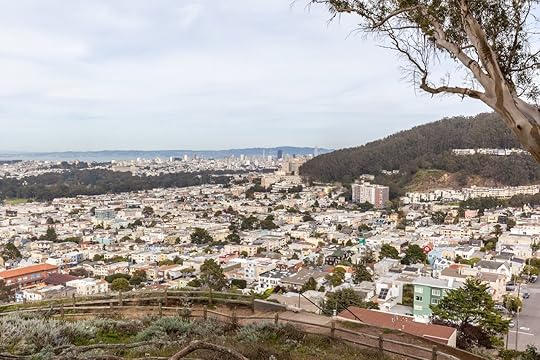
Photo: JHVEPhoto/Shutterstock
Leaving the park, you’ll enter the Inner Sunset, a busy neighborhood with tons of solid lunch spots if you didn’t stop to eat before. Just across from the park on Irving Street are Chinese staple San Tung, which has some of the best chicken wings in SF and typically a long line of locals willing to testify to that fact, and the Taco Shop at Underdogs for those too hungry to wait. In between, there’s The Corner Spot, a fun dive bar where you can cool off with a beer and maybe even squeeze in a quick game of pool. If you’re willing to stray a bit farther from the trail, try Nopalito for fresh, organic Mexican food, best enjoyed on the outdoor patio.
Back to the task at hand, this second section starts at the corner of Judah Street and 16th Avenue, a block from the Hidden Garden Steps just off Kirkham Street. Here, you’ll climb 148 beautifully tiled steps while admiring the floral, at times psychedelic, pattern only to wind up at a second colorful staircase, the 16th Street Tiled Steps. This 163-stair flight is more well-known, showing off a mosaic design reminiscent of Van Gogh’s Starry Night. Stick around a minute to spot green hairstreak butterflies flitting about, then climb to the top and enter Grandview Park.
Living up to its name, the park offers spectacular vistas of the city and Lake Merced at its summit, where you’ll also see a 140-million-year-old rock formation known as the Franciscan chert. From here, the trail cuts through Rocky Outcrop, a small but pleasant open space that’s easy to navigate despite its lack of designated trails. Continue on past Golden Gate Heights Park, a recreation area that’s not worth stopping at except to see the spineflowers and other plant life that inhabits its dunes, until you hit the Forest Hill Muni Metro Station.
Stop at a petting zoo before entering Glen Canyon Park
Distance: 3.1 miles

Photo: Ingus Kruklitis/Shutterstock
Section four kicks off at Laguna Honda Boulevard, where you’ll take a right at the Laguna Honda Hospital and walk up to a wide open space. There, above the hospital, you’ll find the Virginia Leishman Farm, where you can mingle with goats, pigs, and sheep while getting an eyeful of the Sutro Tower, a broadcasting tower and defining SF landmark.
The next trail highlight is Glen Park Canyon, a 60-acre greenway that takes up a significant chunk of this section. On either side of the designated trail, there are two open spaces worth a detour: Twin Peaks, a pair of tall hills that rise above a residential neighborhood and open to incredible views of the entire Bay Area, and Mount Davidson, the highest peak in SF at 927 feet tall. Mount Davidson is about 20 minutes out of the way on foot, but it’s worth seeing, even if that means hopping in a car or bus to make time for the outing.
At Glen Park Canyon, walkers will follow the Islais Creek and Gum Tree Girls trails while cyclists will ride down O’Shaughnessy Boulevard. As you go, admire green hills and creeks, wildflowers and rock formations, and a variety of wildlife taking refuge from the urban development. If you still haven’t eaten, hit up the deli and bakery at nearby Canyon Market for a better meal than you’d expect a grocery store to supply. If, on the other hand, it’s the promise of a cold brew that’s kept you trekking, take a 15-minute detour to St. Mary’s Pub, a local dive where you can play pool and pinball, or fill up on popcorn if you’re feeling peckish.
Wind down at Sunrise Point
Distance: 5.6 miles

Photo: Jeremy Borkat/Shutterstock
For locals, this last leg, or first if you’re a traditionalist, might just be the favorite — as it’s a part of the city most have neglected to visit ever since the Giants’ ballpark moved in 2000. The first stop you’ll want to spend a little extra time on is Alemany Farm, the largest urban farm in SF, where volunteers can sign up to help in exchange for heaps of fresh produce.
Next up is John McLaren Park, second in size only to Golden Gate Park at an impressive 300-plus acres. Walk down Philosopher’s Way toward the Jerry Garcia Amphitheater, named for the Grateful Dead lead guitarist who once lived nearby. The open-air, Greek-style concert venue hosts music and art festivals throughout the year, which is worth noting if you’ll be in town awhile. When it isn’t filled with concertgoers, this park is ideal for birdwatching and traversing more than seven miles of trails. Another highlight is McNab Lake, a nice spot to enjoy a picnic with the snacks you stocked up on at Canyon Market.
Heading back into a more urban area, you’ll cross through Visitacion Valley — home to its own modest greenway with parks, flower and herb gardens, and sculptures — before crossing through Little Hollywood, a quaint family neighborhood with a misleading moniker. This stretch is a pleasant walk but more of a means to an end, which in this case is Sunrise Point in the Candlestick Point State Recreation Area.
Here, you’ll find campgrounds with all the facilities you might need after a long day, as well as unparalleled views of the SF Bay and the East Bay opposite the city. It’ll feel rougher around the edges than Golden Gate or John McLaren Park, but that’s part of what makes Candlestick Point so special, a little-visited part of a city that often feels overwhelmed with people. If you have the energy, spend the rest of the afternoon fishing, windsurfing, birdwatching, and sea lion spotting — or maybe even organize a BBQ to celebrate finishing the Crosstown Trail. 

More like this: The 8 most epic US cities for urban hiking
The post How to tackle the best of San Francisco on foot with the new Crosstown Trail appeared first on Matador Network.

Helsinki bars only open in summer
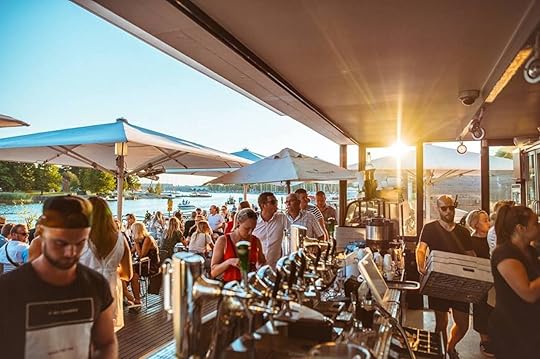
Finland has two seasons: cold and summer. You’ve got cold without snow in October and November, and cold with snow from December to April. In summer, on the other hand, the country is transformed. Leaves return to the trees, deep red strawberries grace farmers markets, and everyone heads outside and to the water.
While some folks depart for one of Finland’s 40,000 islands or 188,000 lakes (yes, you read that right), others opt to enjoy the water and the outdoors right in Helsinki. And since it’s light out into the wee hours, they can enjoy the watery view while listening to DJ-spun beats, cocktail in hand. All over the city, shuttered structures open their doors and put up patio umbrellas. Empty seaside lots become live-music destinations, and rooftops once coated in snow turn into summery party destinations. These are our favorite Helsinki bars that are only open from May to September.
1. Mattolaituri

Photo: Mattolaituri/Facebook
Every summer night, this classic establishment draws Helsinki’s beautiful people to one of the loveliest stretches of the city. For most of the year, Mattolaituri is a non-descript structure covered in snow, located between a large woodsy park and the water’s edge. In summer, Mattolaituri’s doors are open, its white umbrellas, tables, and chairs increasing the structure’s footprint four-fold.
Each evening a golden glow colors the scene as Mattolaituri faces southwest, toward the setting sun — which, at the height of summer, doesn’t dip below the horizon until nearly 11:00 PM. Out front and on the roof upstairs, locals in collared shirts and pastel-hued dresses toss back rosé and people watch, or they admire the boats passing between them and the tiny island less than 100 yards away. On weekends, the DJ spins tunes until the sun is out again.
Where: Ehrenströmintie 3 A, 00140 Helsinki, Finland
2. Allas Sea Pool

Photo: Subodh Agnihotri/Shutterstock
Allas Sea Pool is best known for its incredible pools, built right over the Helsinki harbor and next to the market square, the ferries to Helsinki’s myriad islands, and the President’s Palace. Allas also has a great public sauna. While Allas has dining options all year, its rooftop is only open for drinks in summer. It’s a must-stop after a day spent downtown shopping the Esplanade boutiques for Finnish designware from Marimekko and Iittala. Order some cocktails and head upstairs. Drink in hand, marvel at people swimming laps below you in the seawater-filled pool and savor the beautiful city view behind them.
Where: Katajanokanlaituri 2a, 00160 Helsinki, Finland
3. Löyly

Photo: Löyly/Facebook
Like Allas, Löyly is open all year. While the restaurant serves up amazing salads and an incredible vegetarian pulled “pork” sandwich (you won’t believe it’s made with oatmeal), it’s equally well known for its excellent saunas. The saunas are the reason for its name since löyly refers to the warm feeling you get when water hits hot sauna rocks.
The eye-catching wooden structure is just a 20-minute walk from the Mattolaituri bar. The stroll is worth it, as you can admire Helsinki’s beloved Koivopuisto Park on one side and the isle-dotted sea on the other. In summertime, Löyly’s unusually shaped roof and sloping sides become a prime party destination. Like at Mattolaituri, you’ll want your sunglasses with your cocktail, as you’ll be bathed in a warm sunset sheen for hours.
Where: Hernesaarenranta 4, 00150 Helsingfors, Finland
4. Leblon Merihaka

Photo: Leblon Merihaka/Facebook
For a less swank but hipper scene, head to the other side of Helsinki just past the once-working-class, now trendy, Kallio neighborhood to Leblon Merihaka. This pop-up summer hangout is welcoming all day long, with yoga classes, food stalls, and stand-up paddleboards. When people really show up, though, is the evening hours when singers, bands, and other performers are on the roster. Live music, a cold Lapinkulta beer, and the island-dotted sea make an interesting juxtaposition with Helsinki’s towering inland smokestacks.
Where: Sörnäisten rantatie, 00101 Helsinki, Finland
5. Badenbaden

Photo: Bistro Badenbaden/Facebook
Hietaniemi Beach is a wide stretch of sand that has long been a favored summer destination for lounging, volleyball, swimming, and possibly pretending you aren’t actually at the 60th latitude above the equator. A couple of years ago, beachgoers got the addition of a new building that’s only open in the warmer months.
Badenbaden’s big deck is the perfect place to order a Caipivodka and pretend you really are somewhere tropical — all while never leaving central Helsinki. When you can’t fly south for the summer, it’s a handy Helsinki shortcut for that beachy vacay sensation.
Where: Hiekkarannantie 11, 00100 Helsinki, Finland
6. HSS Paviljong

Photo: Ravintola HSS Paviljong/Facebook
For a more low-key summertime drink by the sea, head to the HSS Paviljong restaurant. While you could probably walk there across the frozen Baltic Sea in January, it wouldn’t be open when you got there. Best to wait until summer when a ferry will take you the ridiculously short distance to this rocky outcrop — an islet that’s called Liuskasaari in Finnish but Skifferholmen in Finland’s other official language, Swedish. It’s not far from Löyly, and you can see the isle from Löyly’s steps.
The restaurant is only open in warm weather, and its terrace is definitely a summer-only fixture. It’s right next to the HSS Sailing Center, so it’s popular with the sailing set. Order a glass of Champagne and watch the sailboats navigating their way around Helsinki’s stunning archipelago.
Where: Liuskasaari, 00140 Helsinki, Finland 

More like this: The best saunas you need to visit in Helsinki, Finland
The post The best Helsinki bars that are only open in the summer appeared first on Matador Network.

Weedmaps Museum of Weed

As more and more states legalize marijuana and the negative stigma begins to dissipate, cannabis is becoming institutionalized like never before. If the dispensaries popping up around every corner weren’t evidence enough, there’s about to be an entire museum dedicated to weed. And of course, it’s opening in Los Angeles, California. The 20,000-square-foot Weedmaps Museum of Weed will open on August 3 in Hollywood and will feature interactive exhibits, art installations, historical artifacts, and more, designed to educate the public and drive advocacy and reform efforts.
Chris Beals, CEO of Weedmaps, said in a press release, “Our goal with the Weedmaps Museum of Weed is to demystify cannabis and its role in society, and to draw attention to the impact prohibition of cannabis has had on various social groups in the US and beyond… The Weedmaps Museum of Weed will combine all the immersive elements you’d expect to find in the world’s finest museums across multiple categories, including cultural, fine art, and natural history. There will also be plenty of artistic installations for those who want to share meaningful moments socially.”
The museum will only be open until September 29, 2019, and also feature a full cafe to satisfy the munchies, and a gift shop with a collection of cannabis paraphernalia and custom apparel. Unfortunately, no cannabis or CBD products will be sold on site.
According to Jonatha Santoro, Executive Creative Director of the creative agency Virtue LA, “The museum will display the antique artifacts you’d expect from a natural history museum, the artwork you’d expect in a modern art museum, the interactive education you’d expect from a family museum, and, yes, even all the mind-melting Instagram opportunities you’d expect from a branded weed museum.”
Tickets are $35 for adults, and they’re already being sold online. 

More like this: Everything to know before going to a state with recreational marijuana
The post A Museum of Weed is opening in California appeared first on Matador Network.

Chefit personal chef dinner in Miami

The restaurant world is caught in a difficult contradiction.
On the one hand, the restaurant-going public is getting a little weary of places where a lunch of chicken salad and Diet Coke somehow comes out to $45.
On the other hand, restaurants are finding it impossible to retain kitchen staff, who in many cities make between $10-$15 an hour, working 12-14 hour days.
Customers don’t want to pay more, so restaurants can’t pay their chefs more, which is a big reason why nearly two-thirds of new restaurants fail within the first three years. It’s a vicious cycle.
But one Florida startup is trying to make things better for both the customers and the chefs. Chefit, founded by cousins Matt Redler and Sabrina Beraja, is bringing people restaurant-quality food from well-trained chefs at almost half the price — all while giving chefs double what they’d make in a traditional restaurant kitchen.
“There are a lot of chefs stuck in restaurants doing high quality work for almost minimum wage,” Redler says. “And they can’t move into being personal chefs because they don’t have the finances or the network. This gives them the chance to start a micro-traveling restaurant by plugging into Chefit.”
The concept is simple: You, the diner, log on to Chefit and peruse its roster of personal chefs. Each one has a specialty cuisine listed in their bio. You check out the menu, find one you like, and book a date for them to come over to your house and cook.
The prices are about 85 percent of what it would be in a mid-range restaurant; think $10-15 apps, $20-25 mains, and $7-10 desserts.
You order family style — one dish serves about two people — online, and then about an hour before dinner, the chef shows up and does their thing. Meanwhile, you relax in the living room, entertain your friends, and wait for food to be served. You drink your own drinks, pour your own wine, and end the night with a bill of about half what it would have been in a restaurant.
Seems like a nice concept, but does it work in practice? Chefit sent a chef over for dinner for a few of my friends so we could find out.
A night in and a night out, all at the same time

Photo: Chefit
If you’ve ever gone out to dinner in a family-style restaurant, you know getting four people to agree on what to order is only slightly easier than herding cats. Continental trade agreements have taken less negotiation, and when it’s done over group chat instead of at a table, it can literally take weeks.
This, fortunately, is the only hassle in the entire process. But if you appoint one person to gather everyone’s preferences and order what’s most popular, you can avoid pretty much any aggravation.
Our group ordered from a chef named Erick, who arrived at my friend’s swanky South Beach apartment a prompt 60 minutes before our designated mealtime. While he chopped, seasoned, and sprinkled, the rest of us caught up over beer and cocktails in the living room. Like a proper cocktail hour before dinner, except we weren’t out $80 before we sat at the table.
After an hour or so of lounging, Chef Erick came out to the living room and announced that dinner was served. We adjourned to the dining room to find a beautifully plated tomato bruschetta set in the center of the table, with four places around it complete with wine glasses.
I opened a riesling I’d recently gotten on a trip to Niagara Falls wine country to pair with the first course. Again, no corkage fee, no additional cost.
The bruschetta was ripe with fresh tomatoes and spicy basil, with shaved parmesan on top. A block away at Il Mulino, this probably would have cost us $25.

Photo: Chefit
The next course was a chicken marsala that held up to any I’d had in Miami. It was served alongside prime beef burgers with a crispy outside and juicy middle, prepared in a pan on the stove. The chefs bring some of their own equipment, but like most personal chefs, they’re able to adapt their menus to whatever space you have.
My friend hosting the dinner opened a bottle of wine he’d brought back from Slovakia, which we couldn’t have found in a restaurant if we’d tried.
Chef Erick prepared dessert while we laughed over our marsala, nearly two bottles of wine deep between four of us. He cleared the table, reset the dishes, then brought out individual apple pies a la mode to finish. There was no lag between courses, and no dishes to clear or wash.
In the confines of my friend’s apartment, this meal for four cost us all of $120 before gratuity. Add in a 25 percent tip to the chef, and that goes up to $150. In Miami, as in many big cities, you’d consider that reasonable for two people. For four people, you’re not finding that price anywhere not called Cracker Barrel.
Chefs benefit along with the guests

Photo: Chefit
Chef Erick was in the apartment maybe three hours total. Chefit, according to Redler, takes a 15 percent cut of the bill, meaning the chef made about $125 in three hours after gratuity. Subtract the cost of ingredients, and that came out to around $30 an hour. Which seemed a little low, until I learned more about the restaurant industry.
Even executive chefs at most restaurants in Miami don’t make much over $65,000 a year. The average salary at the time of writing for an executive chef, according to Glassdoor, is $63,819. When you break that down by the long difficult hours, it’s barely $15 an hour.
“The reason I never took cooking seriously was because I hated the restaurant industry,” said Daniel Gomez, a chef who uses Chefit. “Getting bossed around, yelling, being sweaty and nasty for like no money. But if I can book a dinner a day I’ll make more than I would in a restaurant.”
Gomez specializes in barbecue, cooking for anywhere from two to 13 people via Chefit, meaning he could make triple what our chef-for-four made. He says he enjoys the personal aspect of it, having the ability to interact with guests and give their food special attention.
“When you’re in a restaurant, they’re cooking 100 steaks, and it’s hard to give yours personal attention,” he said. “When I’m cooking for someone in their home, I’m perfecting every part of the meal.”
Programs like Chefit can work better for aspiring personal chefs than striking out on their own because there’s no networking to be done. And, according to Redler, the chef doesn’t have to pay for job leads like they do with other services. Chefit only makes money when a chef gets paid.
“They treat their chefs very well,” said Gomez, who also works as a Keto coach, among other things. “I’m making more per dinner, and it lets me focus on things that are important to me.”
The concept also lets those of us who can’t afford Fendi rugs live like we can. Because if you can afford dinner in a mid-range restaurant, Chefit is totally within your price range.
“People are so excited to have a personal chef in their house,” Gomez said of his guests’ reactions. “To have someone come into your house, and cook for you, and entertain your party, it makes you look cool. People are gonna be jealous when you post that, like, ‘Where’d you get a personal chef?’”
For now, the program is limited to South Florida, but Redler says his eyes are on nationwide expansion.
As one who eats in restaurants more than I should, this seems like an ideal way to start a night out. There’s no stressing about making a reservation, no debating what to order, and nobody getting mad when one person orders six martinis and drives up an evenly split bill.
For our part, we used the dinner as the perfect pregame and hit a club a couple of miles away afterward to end the night. But if you wanted to finish your big Saturday night by going into a food coma on your couch, well, there’s no need to find an Uber either. 

More like this: Where to eat in Miami, according to Miami’s best chefs
The post You can now have a personal chef for less than the cost of eating out appeared first on Matador Network.

Matador Network's Blog
- Matador Network's profile
- 6 followers



